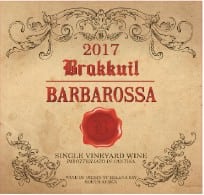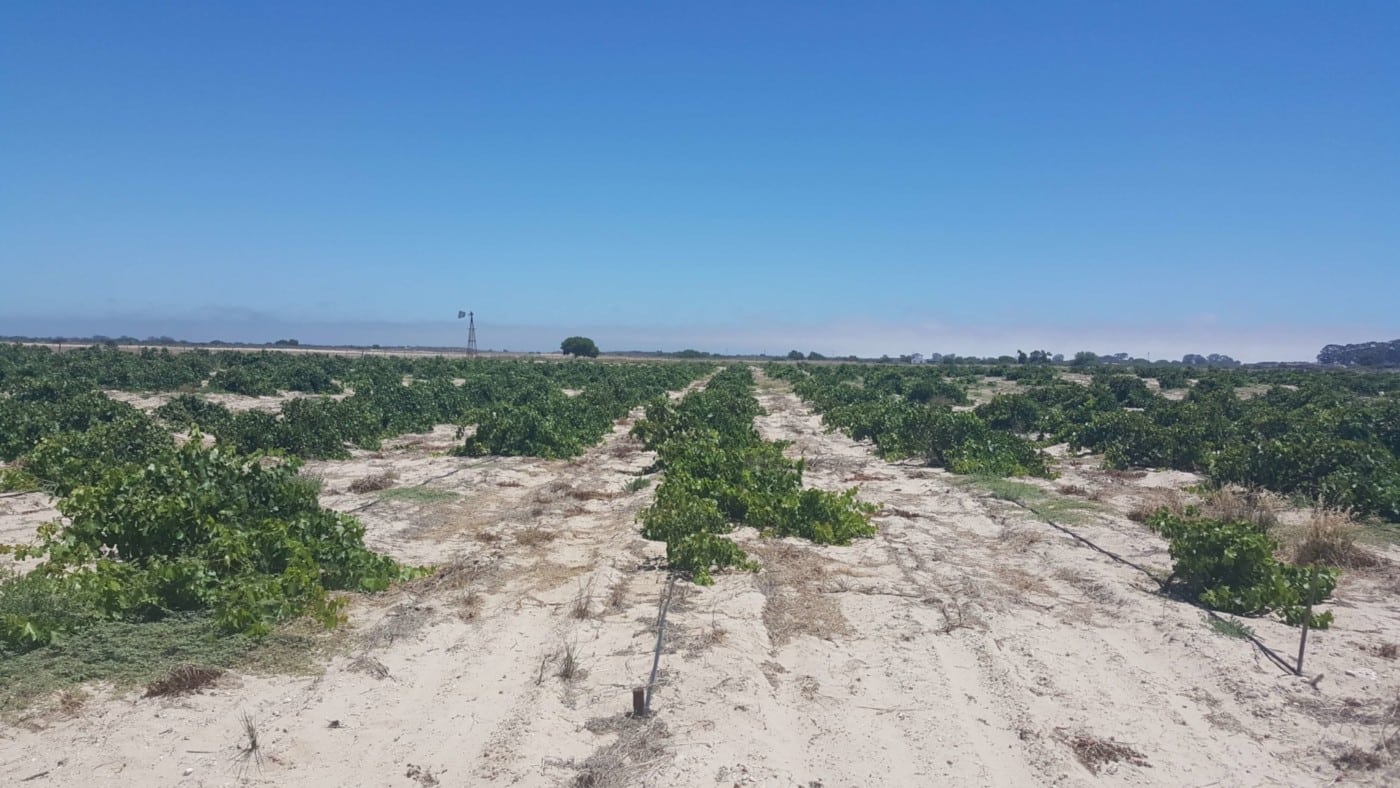Tim James: On the Barbarossa that isn’t a Barbarossa
By Christian Eedes, 11 June 2018

5
One of the Cape’s most extraordinary wine-growing areas, and one of the most obscure, is inland from St Helena Bay on the Atlantic coast, many hours’ drive north from Cape Town. After I first visited it some years back, to see the vineyard from which Eben Sadie gets the grapes for his Skerpioen, I wrote about an “arid landscape, without magnificence or overt charm”, and said ‘it took a walk through a vineyard before I felt it start to grip my imagination.”
There is white sand instead of what one thinks vineyard soil should be like, there is some limestone – rare in the Cape; precious little rain falls (perhaps 200 mm per year at best), but the moisture-laden sea air allows vines to do more than survive these most unlikely-looking conditions.
Twelve or so hectares of vines grow on Brakkuil, the Bouwer family’s 850-hectare farm (where cattle and springbok are more common). And of those, there are less than two hectares of a grape they call barbarossa, the vines planted in 1978 and all that remains of the farm’s original vineyards, which had been badly neglected by the time the Bouwers took over in 2002, and mostly needed to be pulled up.
The vines are not actually barbarossa, despite the Wine and Spirit Board’s blessing – but I’ll come back to that.
 A few years ago, in partnership with farmer Wimpie Bouwer, the grapes were vinified by Adi Badenhorst in his Paardeberg winery, and bottled in 2014 as Brak-kuil Barbarossa (it lost the hyphen in 2015). But now, Brakkuil Barbarossa, with a wholly new label, is being made in the old winery on the farm by young John Bouwer, who tells me that his burning ambitions to make wine date back to a Std 8 school outing to Neethlingshof. The 2017 is the first release in what will be a range of wines from Brakkuil – I’m looking forward to trying the Palomino 2017 (though that seems to be under than brand name Barren Sands, which is a bit confusing). And there’s a 2018 version of another exciting wine associated with Adi Badenhorst (but made by John – hence the name: John Strikes Again From Under a Veil of Good Fortune), from sauvignon blanc, of all things, and matured under a veil of yeast in Jura vin jaune style.
A few years ago, in partnership with farmer Wimpie Bouwer, the grapes were vinified by Adi Badenhorst in his Paardeberg winery, and bottled in 2014 as Brak-kuil Barbarossa (it lost the hyphen in 2015). But now, Brakkuil Barbarossa, with a wholly new label, is being made in the old winery on the farm by young John Bouwer, who tells me that his burning ambitions to make wine date back to a Std 8 school outing to Neethlingshof. The 2017 is the first release in what will be a range of wines from Brakkuil – I’m looking forward to trying the Palomino 2017 (though that seems to be under than brand name Barren Sands, which is a bit confusing). And there’s a 2018 version of another exciting wine associated with Adi Badenhorst (but made by John – hence the name: John Strikes Again From Under a Veil of Good Fortune), from sauvignon blanc, of all things, and matured under a veil of yeast in Jura vin jaune style.
Brakkuil Barbarossa 2017 was made in hands-off fashion – spontaneous fermentation, etc, and very low sulphur addition. It’s ripe (14% alcohol) and quite rich, with plenty of sweet-fruited velvety smoothness. As was also true of the Badenhorst version, the perfume is rather cinsaut-like, and there’s both brightness and darkness to the wine’s fruit character. John’s version is less structured, however, with the gentlest of tannic grips, and perhaps a touch less fresh. Unchallenging even in extreme youth, and undoubtedly pretty delicious.
The variety, though…. It seems pretty certain (as explained by Dr Jerry Rodrigues in a comment on my Winemag note about Adi’s 2014 Barbarossa) that the variety in the Cape is not the Italian barbarossa – whatever that is: it’s described in Robinson, Harding and Vouillamoz’s authoritative Wine Grapes guide as the “confusing name for several, possibly unrelated, varieties”. Dr Rodrigues points out that “The Barbarossa grapevine that grew in the Cape area (especially around Constantia), was identified by Prof. Abraham Perold way back in 1927 (in his ‘Treatise on Viticulture’) as being none other than the French cultivar called Danugue (aka Gros Guillaume).” Danugue is, in fact, a French table grape, not used there for wine.
So why did Nietvoorbij more recently get the identification wrong, by settling for the old (mis)understanding? Inexcusable, surely. It’s a pity there is this confusion about the variety, and perhaps the authorities will eventually sort it out. “Brakkuil Danugue” would sound just as intriguing and rare! But, I dare say, remembering the appalling history of crouchen blanc being encouraged by the Wine and Spirit Board to masquerade as riesling for so long, it might take a lot of pushing!
And, ah well, it doesn’t matter too much. Barbarossa is unlikely to ever move from occupying the tiniest niche here. The wine, anyway, is a welcome, charming addition to what the Cape has to offer. Look out for the Brakkuil (it’s not going to be cheap or great value, I think, perhaps R200 at least); not available via retail yet, but it should be soon. If you’re in a hurry to try it, though, you could contact the producer via the well-illustrated website and see. Just 2400 bottles were made in 2017, but John says there’ll be more 2018.
- Tim James is one of South Africa’s leading wine commentators, contributing to various local and international wine publications. He is a taster (and associate editor) for Platter’s. His book Wines of South Africa – Tradition and Revolution appeared in 2013.








Bernard De Boer | 11 June 2018
Damn,
I’m going to mis the ‘red beard wrestling the crocodile’ version of Adi. It was a beaut
James | 11 June 2018
Hi Tim
Can you clarify something for me? The brochure on the site states “For many years the Barbarossa vines were classed as Cinsaut until W.F. Bouwer bought the farm in 2000 and did an analysis on the Cinsaut which was then classified as Barbarossa”. So what is the deal? Is the producer simply calling it Barbarossa because of the formal classification or do they honestly think it is the grape that everyone else says it isn’t?
Do you know of any other wines that are made from table grapes (assuming it is indeed Danugue)?
Tim James | 11 June 2018
James – Brakkuil do use the word “mystery” a few times on their website. I presume that they can see no reason not to follow the official line, however, which is fair enough. Why not believe the authorities? Unless the authorities recognized danugue as an official variety, that name couldn’t appear on the label – so there’s little choice for the producer if they want to call it anything.
I’m not sure there’s a fundamental difference between table grapes and wine grapes. The main differences must lie in custom and then how clones are chosen and developed, how the grapes are farmed etc. Of course, table grapes must be especially tasty and loose bunched and look good. Who’s to say that hanepoot is a table Grape or a wine one? It works pretty well as both. And probably most muscat varieties would. But I can’t immediately think of other well known examples where the same grape is used for both purposes, though I’m sure in some countries there must be some.
Edyss Scott | 4 October 2019
Hi Tim, very interesting article as I own 2 bottles of the 2017 Brakkuil Danurossa… ladies in waiting they are. What would you say would their ageing potential be? I have no idea, as I’ve not tasted it at all and hearing it is not really Barbarrossa (not that I got a problem with that – the mystery deepens). Wait till 2022 for the 1st one to see what what it says or take a chance and go for 2025???
Jo Prins | 29 May 2024
The red bearded croc wrestler looks more like Charl, Adi’s brother.